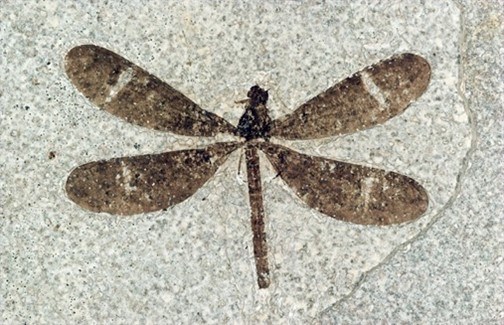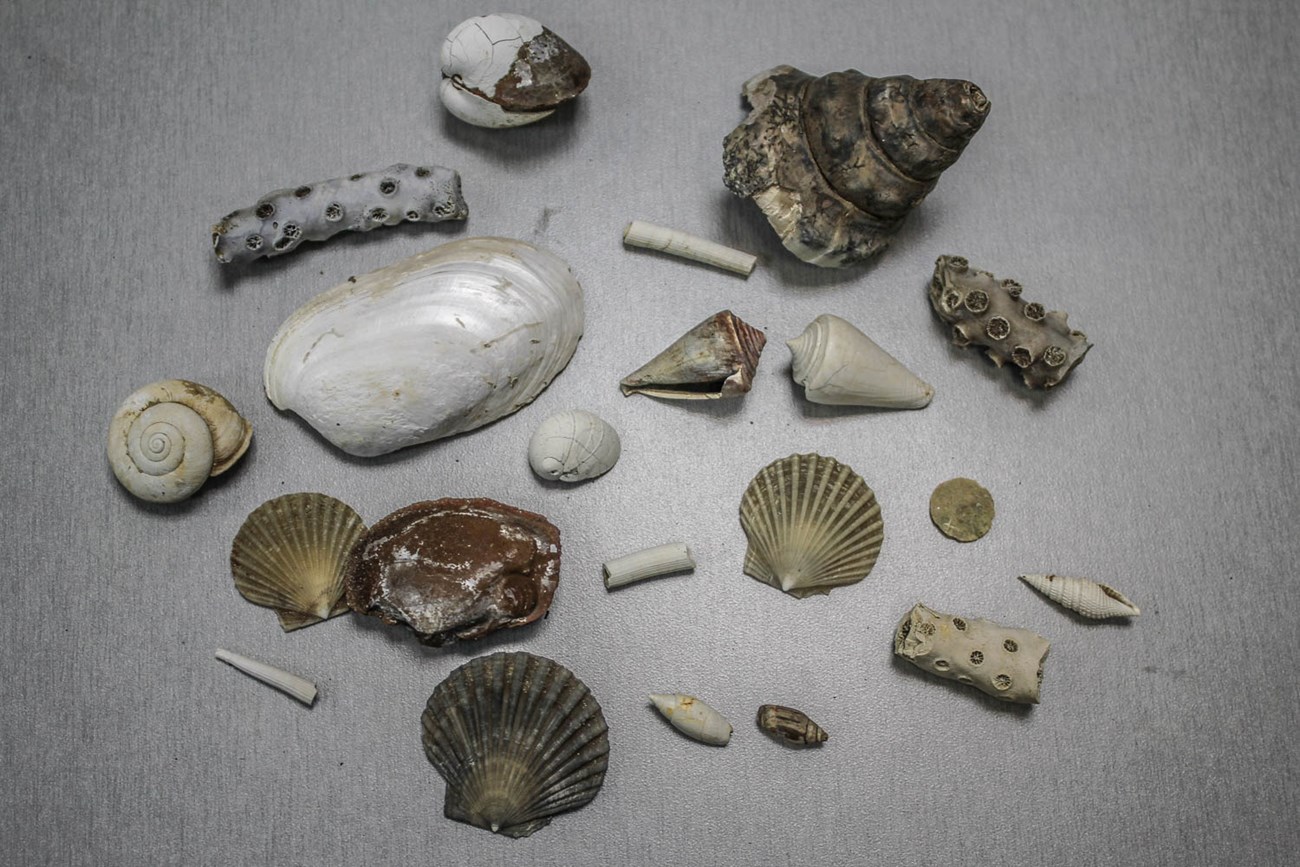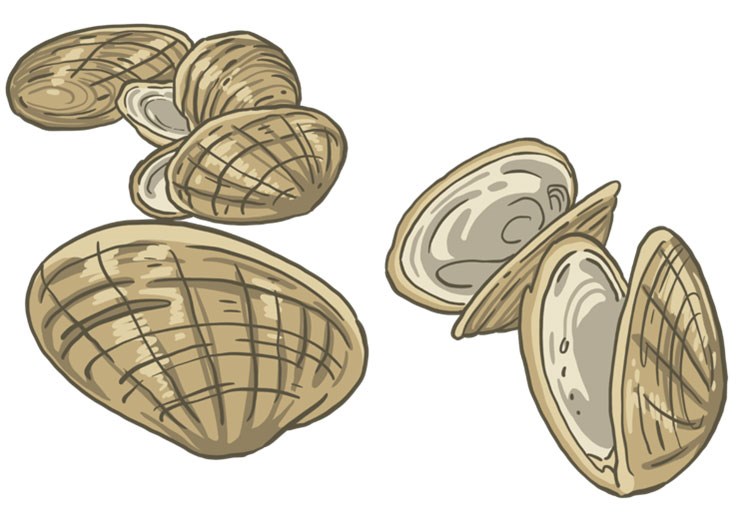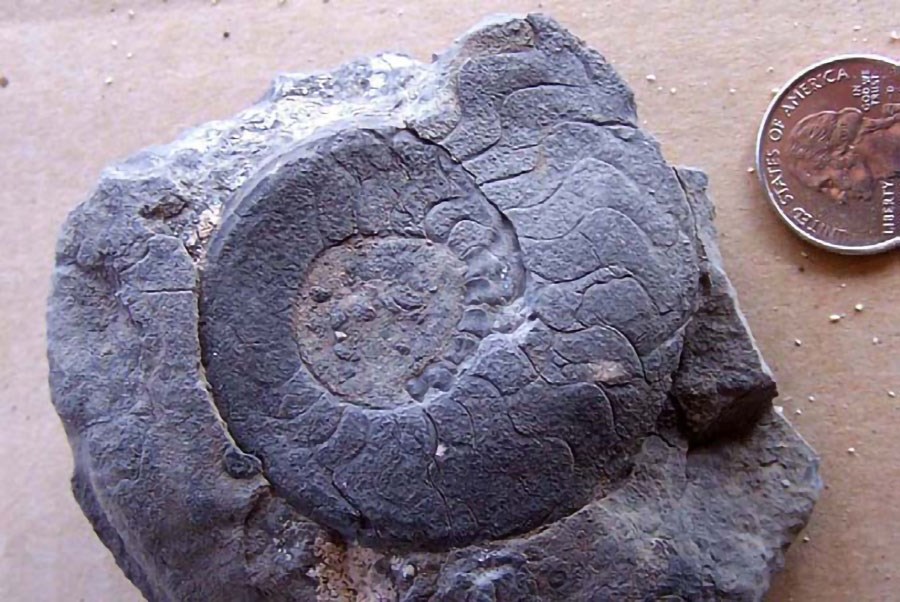

Left image
A selection of Upper Ordovician fossils from Mississippi National River and Recreation Area, Minnesota.
Credit: Photo by Justin Tweet.
Right image
Same.
Introduction
Most of the animal life of Earth throughout geologic time has consisted of animals without backbones. Animals without backbones are invertebrates, that is, organisms that lack interlocked vertebrae to form a backbone or segmented spinal column. Invertebrates include marine and freshwater animals with internal or external shells or tests, but also terrestrial snails, insects, and spiders. Some invertebrates, such as various types of “worms,” are entirely soft-bodied.
Invertebrate fossils are the most widely encountered of the major groups of fossils in national parks. They have been documented in at least 235 units of the National Park System.
Parks from Florida to Alaska contain invertebrate fossils, ranging in age from the beginning of the Cambrian to near the present day. Paleozoic invertebrate fossils are found in parks across the country because sedimentary rocks that are Paleozoic in age are widely distributed. Mesozoic invertebrate fossils are particularly abundant in parks in the Great Plains and Rocky Mountains due to the Cretaceous-age Western Interior Seaway, which left marine rocks from that period in those areas. Parks containing Cenozoic marine invertebrate fossils are restricted to the coastal plains along the Atlantic seaboard and Gulf of America, as well as some areas near the Pacific coast. Cenozoic terrestrial invertebrates are found in some parks in the Intermountain West.
How Invertebrates Are Fossilized
As for any fossil, rapid burial and the existence of hard body parts greatly increase the odds of fossilization. The overwhelming majority of invertebrate fossils are those of the shells or hard exoskeletons of marine and freshwater organisms.
Most invertebrate fossils are replaced or recrystallized shells or tests, or natural molds or casts. Fossils of aquatic organisms with shells or exoskeletons such as mollusks, brachiopods, corals, crinoids, and trilobites are abundant in many sedimentary rocks. The soft parts of these organisms are rarely preserved. The remains of invertebrates without hard parts are generally quite rare in the fossil record.
Fossils of terrestrial invertebrates, apart from air-breathing snails, are rare in the fossil record except under certain depositional conditions. Conservation Lagerstätten such as at Fossil Butte National Monument, Florissant Fossil Beds National Monument, and Glacier National Park include many significant fossils of insects.
Learn More
Park Examples
Fossil Butte National Monument, Wyoming

The chemistry of the Eocene Fossil Lake was critical to the preservation of the wide variety of fossils known from Fossil Butte National Monument. Near the bottom of this lake, there was a layer of oxygen-poor water that prevented decay and scavenging as well as a microbial mat that encased dead organisms. As a result, the fish that made the monument famous fossilized, as well as fossils of a wide variety of other organisms, including insects such flies, wasps, and damselflies that lack hard parts.
Learn More
Vicksburg National Military Park, Mississippi and Louisiana

NPS photo.
Vicksburg National Military Park contains some of the best-preserved Oligocene fossils in the world, including bivalves, gastropods, and corals. These organisms had shells, in the case of bivalves and gastropods, or hard skeletons, such as those made by the communal corals. Many of the invertebrate fossils in the Vicksburg Group are made of aragonite, which is the original calcium carbonate mineral precipitated by many invertebrates. Particularly in older fossils, the original aragonite has been recrystallized to calcite.
Park Links
Environments that Invertebrates Inhabited
Invertebrate animals evolved in the oceans and then have spread to fill nearly every niche and environment on Earth. The invertebrate fossil record begins in the latest Precambrian and has continued throughout the Phanerozoic.Fossils of invertebrates are usually found in rocks that have been deposited in one of three main environments:
-
Marine
-
Freshwater
-
Terrestrial
Marine invertebrates are by far the most common type of fossil in the rock record for several reasons. First, large numbers of diverse invertebrate animals live in oceans. Second, many marine invertebrates have hard parts like shells or exoskeletons, which are much more likely to be preserved than soft parts. Finally, marine environments are depositional basins, which also favors fossilization.
Freshwater environments are rare compared to marine environments, but invertebrate fossils, particularly of mollusks (bivalves and some gastropods), are known from some fluvial (river) and lacustrine (lake) environments.
Fossils of terrestrial invertebrates such as insects are overall quite rare in the fossil record. Many insects live in environments that are not depositional basins and lack robust hard parts, instead having exoskeletons that are easily destroyed. Fossil insects only occur with some abundance and regularity in certain lake environments, where unique characteristics of their depositional environments created conditions that preserved their fragile remains.
Park Examples
Dinosaur National Monument, Utah and Colorado

NPS image by Molly Swindle.
The Morrison Formation in Dinosaur National Monument is best known for its iconic dinosaur fossils, including the more than 1,500 bones exposed in the wall of bones in the Quarry Exhibit. But the Morrison also contains a diverse fossil record of plants and animals that lived about 150 million years ago during the Jurassic Period. In fact, fossils of unionid mussels are common along with dinosaur fossils in the Quarry Exhibit Hall exposures. Today unionids prefer flowing freshwater such as in rivers, inhabited by fish that their larvae can attach themselves to. Finding unionid fossils in abundance provides key evidence of environment in which the dinosaur bones accumulated.
Park Links
Florissant Fossil Beds National Monument, Colorado

NPS Photo
The fossil insects present in Florissant Fossil Beds National Monument include many groups that lived in a variety of terrestrial environments, such as flies, wasps, and months. They became fossilized after their remains fell into the freshwater Lake Florissant. Paper shales deposited in this lake preserved many impressions and compressions of insects and spiders.
Park Link
Guadalupe Mountains National Park, Texas

Guadalupe Mountains National Park contains a wealth of invertebrate fossils deposited in a marine environment. The park contains rocks deposited in a Permian reef system. The Capitan Formation and other rock units exposed in the park contain many different kinds of invertebrate fossils, including sponges, horn corals, bryozoans, brachiopods, cephalopods, gastropods, trilobites, crinoids, and even sea urchins.
Learn More
Invertebrate Taxonomy
Most invertebrate fossils come from one of eight major groups:
-
Porifera – Sponges
-
Cnidaria – Corals, jellyfish, and sea anemones
-
Bryozoa
-
Brachiopoda
-
Mollusca – Bivalves, gastropods, cephalopods and others
-
Arthropoda – Trilobites, spiders, insects, and others
-
Echinodermata – Crinoids, blastoids, and others
-
Graptolithina
Six of these groups are of marine organisms (with a few freshwater exceptions) that often have shells or other hard structures that increase the odds that they will be fossilized. The other two, mollusks and arthropods, are found in marine, freshwater, and terrestrial environments.
Other groups of invertebrate animals exist, but the eight listed above contain organisms that are well-represented in the fossil record.
Invertebrate Fossils in National Parks
National parks contain a rich diversity of invertebrate fossils. Some groups, particularly mollusks, are present in many national parks, but others are much more rare. Most invertebrate fossils in national parks are of marine organisms, although some parks have freshwater mollusks, and a few have fossils of terrestrial arthropods, mostly insects.
-
 Fossil Sponges
Fossil SpongesSponges have a fossil record dating back to the Precambrian. They were dominant reef builders in the Paleozoic.
-
 Fossil Cnidarians
Fossil CnidariansCorals are the most common type of cnidarian in the fossil record of national parks.
-
 Fossil Bryozoans
Fossil BryozoansBryozoans are colonial filter-feeders that live in oceans and have an extensive fossil record, dating to the Early Ordovician.
-
 Fossil Brachiopods
Fossil BrachiopodsBrachiopods had their heyday during the Paleozoic and occupied many of the ecological niches now filled by bivalves.
-
 Fossil Mollusks
Fossil MollusksMollusks, a large diverse group of invertebrates, have an extensive fossil record, including that of bivalves, cephalopods, and gastropods.
-
 Fossil Arthropods
Fossil ArthropodsTrilobites are the most common type of arthropod fossil in national parks, although insect fossils are also present in some units.
-
 Fossil Echinoderms
Fossil EchinodermsCrinoid fossils are common in fossiliferous Paleozoic rocks. Other echinoderms like blastoids and starfish are known from some parks.
-
 Fossil Graptolites
Fossil GraptolitesGraptolites, a type of marine colonial organism, have been found in early Paleozoic marine sedimentary rocks in several national parks.
Related Stories
Coloring Book Pages
Featured Parks
-
Dinosaur National Monument (DINO), Colorado and Utah—[DINO Geodiversity Atlas] [DINO Park Home] [DINO npshistory.com]
-
Florissant Fossil Beds National Monument (FLFO), Colorado—[FLFO Geodiversity Atlas] [FLFO Park Home] [FLFO npshistory.com]
-
Fossil Butte National Monument (FOBU), Wyoming—[FOBU Geodiversity Atlas] [FOBU Park Home] [FOBU npshistory.com]
-
Guadalupe Mountains National Park (GUMO), Texas—[GUMO Geodiversity Atlas] [GUMO Park Home] [GUMO npshistory.com]
-
Vicksburg National Military Park (VICK), Louisiana and Mississippi—[VICK Geodiversity Atlas] [VICK Park Home] [VICK npshistory.com]
Last updated: February 27, 2025
